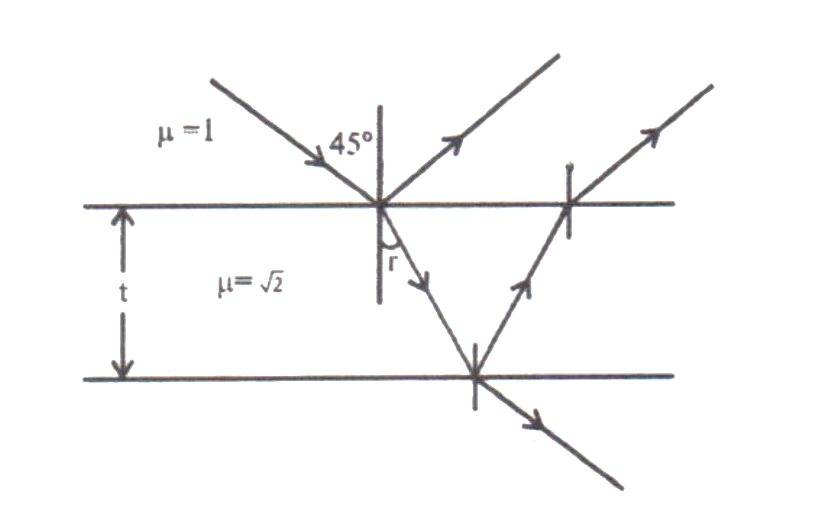Calculate the minimum thickness of a soap bubble film (μ=1.33)that results in constructive interference in the reflected light if the film is illuminated with light whose wavelength in free space is λ=600nm.
To calculate the minimum thickness of a soap bubble film that results in constructive interference in the reflected light, we can follow these steps:
Step 1: Understand the condition for constructive interference
For constructive interference in a thin film, the condition is given by the formula:
2μt=(n−12)λ
where:
- μ is the refractive index of the film,
- t is the thickness of the film,
- n is an integer (1, 2, 3,...),
- λ is the wavelength of light in free space.
Step 2: Identify the values given in the problem
From the problem, we have:
- μ=1.33
- λ=600nm=600×10−9m
Step 3: Set up the equation for minimum thickness
To find the minimum thickness, we will use the smallest integer value for n, which is n=1. Substituting n=1 into the formula gives:
2μt=(1−12)λ
2μt=12λ
Step 4: Solve for thickness t
Rearranging the equation to solve for t:
t=λ4μ
Step 5: Substitute the values of λ and μ
Now substituting the values:
t=600×10−9m4×1.33
Step 6: Calculate the thickness
Calculating the denominator:
4×1.33=5.32
Now, substituting this back into the equation for t:
t=600×10−95.32
Calculating this gives:
t≈112.78×10−9m
or
t≈112.78nm
Final Answer
The minimum thickness of the soap bubble film is approximately 112.78 nm.
---
For constructive interference in a thin film, the condition is given by the formula:
2μt=(n−12)λ
where:
- μ is the refractive index of the film,
- t is the thickness of the film,
- n is an integer (1, 2, 3,...),
- λ is the wavelength of light in free space.
From the problem, we have:
- μ=1.33
- λ=600nm=600×10−9m
To find the minimum thickness, we will use the smallest integer value for n, which is n=1. Substituting n=1 into the formula gives:
2μt=(1−12)λ
2μt=12λ
Rearranging the equation to solve for t:
t=λ4μ
Now substituting the values:
t=600×10−9m4×1.33
Calculating the denominator:
4×1.33=5.32
Now, substituting this back into the equation for t:
t=600×10−95.32
t≈112.78×10−9m
or
t≈112.78nm
The minimum thickness of the soap bubble film is approximately 112.78 nm.
Topper's Solved these Questions
- INTERFERENCE AND DIFFRACTION OF LIGHTBook:DC PANDEYChapter:INTERFERENCE AND DIFFRACTION OF LIGHTExercise:Example Type 2
Explore 2 Videos
- INTERFERENCE AND DIFFRACTION OF LIGHTBook:DC PANDEYChapter:INTERFERENCE AND DIFFRACTION OF LIGHTExercise:Example Type 3
Explore 2 Videos
- INTERFERENCE AND DIFFRACTION OF LIGHTBook:DC PANDEYChapter:INTERFERENCE AND DIFFRACTION OF LIGHTExercise:Level 2 Subjective
Explore 5 Videos
- GRAVITATIONBook:DC PANDEYChapter:GRAVITATIONExercise:All Questions
Explore 120 Videos
- MAGNETIC FIELD AND FORCESBook:DC PANDEYChapter:MAGNETIC FIELD AND FORCESExercise:Medical entrance s gallery
Explore 59 Videos
Similar Questions
An oil film covers the surface of a small pond. The refractive index of the oil is greater than that of water. At one point on the film, the film has the smallest non-zero thickness for which there will be destructive interference in the reflected light when infrared radiation with wavelength 800 nm is incident normal to the film. When this film is viewed at normal incidence at this same point, for what visible wavelengths, if any, will there be constructive interference? (Visible light has wavelengths between 400nm and 700 nm )
View SolutionRefractive index of a thin soap film of a uniform thickness is 1.38. The smallest thickness of the film that gives an interference maxima in the reflected light when light of wavelength 5520 Å falls at normal incidence is
View Solution
Knowledge Check
What is the minimum thickness of a thin film (μ=1.2) that results in constructive interference in the reflected light? If the film is illuminated with light whose wavelength in free space is λ=500nm ?
A104 nmB200 nmC300 nmD400 nmWhat is the minimum thickness of thin film required for constructive interference in the reflected light through it ?
(Given, the refractive index of the film =1.5, wavelength of the lilght incident on the film =600 nm.A100nmB150nmC200nmD250nmWhat is the minimum thickness of a soap bubble needed for constructive interference in reflected light, if the light incident on the film is 750 nm? Assume that the refractive index for the film is n=1.33
A282 nmB70.5nmC141 nmD387 nm
Refractive index of a thin soap film of a uniform thickness is 1.34. Find the smallest thickness of the film that gives in interference maximum in the reflected light when light of wavelength 5360Å fall at normal incidence.
View SolutionIf the wavelength of incident light on a soap film is 700 nm then its minimum thickness 10 t nm so that constructive interference in reflected light can be observed. The value of t is ………..[Take refractive index of the film as 43]
View SolutionWhite light is sent downward onto a horizontal thin film that is sandwiched between two materials. The indexes of refraction are 1.80 for the top material, 1.65 for the thin film, and 1.50 for the bottom material. The film thickness is 5.00×10−7 m. Of the visible wavelengths (400 nm to 700 nm) that result in fully constructive interference at an observer above the film, which is the (a) longer and (b) shorter wavelength? The materials and film are then heated so that the film thickness increases. (c) Does the light resulting in fully constructive interference shift toward longer or shorter wavelengths?
View SolutionWhat is the minimum thickness of thin film required for constructive interference in the reflected light through it ?
(Given, the refractive index of the film =1.5, wavelength of the lilght incident on the film =600 nm.
View SolutionA ray of light is incident at an angle of 45∘ (ralative to the normal) on a thin film of a liquid with an index of refraction of √2. Assuming that the medium of both sides of the film is air, find the minimum thickness of the film required for constructive interference in the reflected light for sodium light of wavelenght 600 nm.

View Solution
